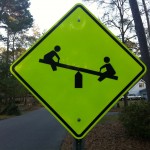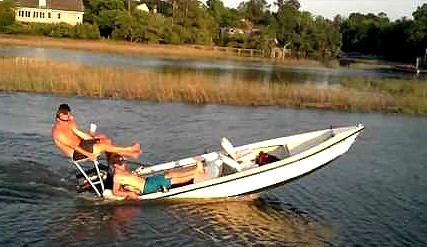CB... What the heck is it anyway?
Posted by Glen Witt on May 9th 2013
 CB is the abbreviation for "Center of Buoyancy" used on Glen-L plans. The CB can be compared to the fulcrum of an in-balance teeter-totter. The CB is the longitudinal balance point of the underwater volume. Add weight aft of the CB and the boat will go down by the stern, forward and it will be down at the bow.
CB is the abbreviation for "Center of Buoyancy" used on Glen-L plans. The CB can be compared to the fulcrum of an in-balance teeter-totter. The CB is the longitudinal balance point of the underwater volume. Add weight aft of the CB and the boat will go down by the stern, forward and it will be down at the bow.
When the designer designs a boat of any size, he calculates the underwater volume, estimates the displacement, and determines the CB, however this initial figure is only a starting point. The weights of all the fixed components in the finished boat must actually be calculated. Yes, this means figuring the weight of each batten, gusset, keel, plank, plus everything in the boat including passengers, motor, etc. Hopefully, the total weight should be very close to the original displacement estimate. If not, the displacement must be re-figured to match the calculated weights and a new CB point determined.
Now comes the fun. Each component part of the boat must have the location of its center of gravity measured relative to the CB; this is then multiplied by its weight. When finished, the designer has a long list including each part of the boat with the distance x weight listed; if the total of figures fore and aft the CB are equal, the hull is in balance. Obviously, this is seldom the case. When not, some weights must be shifted to bring the hull into balance.

Although the weights of the components of the hull are fixed, some objects can be moved; fuel and water tanks are easily shifted and are usually the first choice of most homebuilders. But are tanks empty or full? Although designers use a half-full figure, due to the varying weight, the liquids are best located as close to the CB as possible. It isn't good practice to move passengers to balance the hull. Although the location of the helmsperson is usually fixed, it isn't practical to specify where each passenger must sit. It is simply a process of elimination to determine what can be shifted and how much. Back to our teeter-totter: the farther an object is from the CB, the more its weight affects the balance. A "weight-value" for each component is figured by multiplying the distance from the CB by its weight. A weight of 10 pounds 1' aft of the CB could be balanced by 2 lbs. 5' forward: 10 x 1 = 2 x 5. In extreme cases, the designer may find it necessary to alter the boat lines to shift the CB, however the options are limited by the parameters of the design. This, sometimes frustrating balancing act, is the reason many designers are gray haired or bald.
Displacement or semi-displacement powerboats can be brought into trim by adding ballast. Balancing a sailboat can often be accomplished by moving existing ballast. However, as speed is a function of weight in planing boats, adding ballast for balance is undesirable.
Fast planing powerboats are usually not designed to be in balance at rest. In a typical 10' outboard planning hull, the driver can often shift his weight forward to get the boat quickly on plane, then shift aft and the hull will be relatively level. Obviously shifting the driver forward far enough to have an effect in a larger boat is impractical. Outboards with power trim, afterplanes (cavitation plates) and similar appendages will lift the stern and bring the hull on plane more quickly. Any fixed appendage used to force the bow up or down causes resistance and detracts from performance.
Open planing craft, such as deck boats with lots of passenger space, are only in balance with certain loading. The typical bow rider seems to invite everyone up forward but this imbalance becomes dangerous if carried to the extreme. For best performance, cruising type boats of any size will have superior performance if properly balanced about the CB.
When balance is an important factor, our plans show the CB on the lines drawings. If you are thinking of adding extra fuel in that big open bow space, think again. What are you going to locate aft to balance the weight x distance contemplated forward? Keep the boat in balance for best performance.
